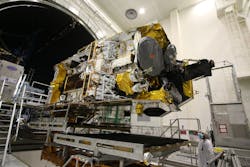Eyes in the sky - today's military SATCOM
By Megan Crouse
NASHUA, N.H. - Satellite communications (SATCOM) literally expanded humanity’s horizons, enabling ships, aircraft, and land vehicles to communicate over the curve of the Earth. With thousands of communications satellites in the sky today a lot has changed since their advent, as the technology is continuing to move forward. Meanwhile, U.S. military and government decisions makers are trying to increase on-orbit interoperability.
Brief history of SATCOM
Satellite communications enable an aircraft to communicate via satellite with air traffic control and other ground-based facilities while in the air. It can include voice and ground service, and unlike very high frequency (VHF) terrestrial radio stations or conventional ground radar, can operate beyond line of sight.
In the commercial world, people are looking to SATCOM for improved air traffic control, which could enable more planes to fly safety in the same airspace at the same time; more efficient routing; and tailored arrivals to negate the need for inefficient step descents, which has been trialed at airports in Los Angeles and San Francisco.
“With the arrival of internet protocol (IP)-based applications and new data-hungry cockpits, SATCOM will deliver critical safety data as well as improve operationalWhile this is still relevant background information, military applications in 2021 are part of a slightly different conversation. Officials of the U.S. Defense Advanced Research Projects Agency (DARPA) in Arlington, Va., are looking at new ways to connect satellites. In September 2021, they issued a solicitation for a reconfigurable multi-protocol intersatellite optical communications terminal. Specifically, they’re looking for two technical areas of the Space-Based Adaptive Communications Node (Space-BACN) project, one of the two major DARPA projects in this area today.
“There’s a long history of reliance on commercial capabilities in the satellite communication realm by the Department of Defense, the intelligence communities and the whole national security apparatus,” says Rebecca Cowen-Hirsch, senior vice president of government strategy & policy at Inmarsat Government in an interview with Military & Aerospace Electronics in October 2021.
“Going back nearly a generation now, where the defense satellite communication program operations at that point in time during Desert Storm and in that epoch, there were gaps in programs, there were technological challenges and the satellite communication capabilities on the commercial side were really coming into their own. And at that stage once deployments began, the dependence on commercial satellite communications became integral to successful operations for deployments overseas. And as time has progressed forward, the commercial industry has advanced technologically significantly faster not only in capability but in deployment capacity and coverage, as well as advancements in the type of mobility operations that are employed broadly across the commercial arena.”
When it comes to SATCOM, size, weight, and power consumption (SWaP) matters, Inmarsat’s Cowen-Hirsch says, but so do “reliable components that will maintain our regulatory compliance, so that we actually control our off-axis EIRP to ensure that we’re not causing unintentional interference to any other adjacent satellite. So we respect those regulatory restrictions and also want to be able to get the greatest throughput that we can with this smallest size terminal. This is a demand signal that we’ve read and indicated very clearly from our user community.”
Current DARPA projects
DARPA is working on several new SATCOM efforts today. One seeks to resolve the issue that there is no standardization today for inter-satellite links in low-Earth orbit (LEO). Space-BACN seeks to change that, providing standards and hardware for space-based communications, optical intersatellite links, reconfigurable modems, modular components, and space command and control.
Today’s new satellite constellations often communicate using single-waveform crosslinks. These almost always consist of custom-made components, makingThe second major project is the Blackjack program. Started in 2017, it calls for a constellation of surveillance satellites with a high-speed network to replace existing, larger systems, including the classified Misty project. In part by incorporating commercial components, they plan to be able to swap out systems easily if they are damaged or destroyed. The first wave will see DARPA launch 12 satellites on board a SpaceX Falcon 9 rideshare in 2022, although this may face delays. In the end, DARPA plans for the constellation to have as many as 20 satellites.
It was founded before the departmental restructuring that led to the creation of the U.S. Space Force and Space Command. Starting out as a broad request for possible technologies and uses, it has narrowed its focus as companies sign on, but also is pursuing the ability to pivot as necessary.
Some of the latest news on this a DARPA award to Lockheed Martin, the prime contractor, of $25.3 million in early September. On top of existing $13.1 million and $27.3 million contracts, that brings the contract total to $65.8 million. In addition, DARPA has ordered 10 buses from Blue Canyon Technologies LLC in Boulder, Colo; two from Telesat in Ottawa; and additional payloads from the Raytheon Technologies Corp. Intelligence & Space segment in El Segundo, Calif.; SEAKR Engineering Inc. in Centennial, Colo.; and SEAKR Photonics Inc. in Los Gatos, Calif. SEAKR will provide the so-called Pit Boss artificial intelligence coordinator for Blackjack.
DARPA also awarded an undisclosed amount in a Small Business Innovation Research contract to Augustus Aerospace Co. in Colorado Springs, Colo., for an Army Space and Missile Defense Command payload. Several other companies also are involved in DARPA Blackjack, in including L3Harris Technologies in Melbourne, Fla.; and Danbury Mission Technologies in Danbury, Conn.
In May 2021, Blackjack program manager Stephen Forbes said only two of the current “handful” payloads in consideration are likely to be chosen in the end. Those will probably include a radio frequency system for communications and geolocation and an overhead persistent infrared (OPIR) missile warning payload. Each of these would require a different bus design to incorporate the necessary components such as antennae. The program is working on putting two payloads on one bus, depending on cost.
“We’re still not focused on a specific mission,” Forbes says. “We’re not trying to solve specific capability gaps or technical gaps, related to a specific sensor payload, which is why you continue to see a broad swath of contracts and other activities ongoing with the program because of that architecture.”
Blue Canyon officials put it this way: “By incorporating commercial sector advances in low-Earth orbit, including designs used for LEO broadband internet service, the goal of the Blackjack program is to demonstrate that a constellation of LEO satellites meets U.S. Department of Defense performance and payload requirements, at a significantly lower cost, with shorter design cycles and with easier and more frequent technology upgrades. The Blackjack program aims to establish an economy of scale not previously available with current National Security Space (NSS) assets, which are large, costly and would take years to replace if degraded or destroyed.”
Forbes says the primary Blackjack customer is the U.S. Army, which could use the satellites for tactical utility. That’s an “underserved market,” he says. However, that could change if higher-ups decide they want to ask something different of the satellite makers.
The need for optical inter-satellite links (OSILs) in particular has gone through some changes. The commercial world simply isn’t as far along with these as military researchers would require, Forbes says.
Commercial LEO
The Mandrake 2 experimental satellites under a Blackjack contract are headed for the U.S. Space Development Agency (SDA) National Space Defense Architecture, established in March 2019. This new effort to “disrupt military satellite acquisition” will work toward an eventual ecosystem of hundreds of LEO satellites. They include data communications, hypersonic and cruise missile tracking and enhanced battle management, for a total of seven capability layers. The SDA procured the first satellites for the architecture next year and sought industry feedback for the procurement of the next batch throughout 2021.
LEO in particular is getting more attention. Some within the Pentagon saw it as too expensive and resource-intensive to be worth the effort. However, the SVA says new developments are changing that. Those include Moore’s Law’s effect on computing, the commoditization of satellite parts, artificial intelligence, optical crosslinks and better onboard processors.
Inmarsat’s Cowen-Hirsch says Inmarsat Government’s customers “continually ask for enhanced security, greater mobility, coverage on a worldwide basis. … In defense operations there’s this constant desire to be able to operate through a wide array of environments, whether it is — certainly over broad ocean areas where there is, generally speaking, very little commercial capability outside of maritime and aviation, which is core to our business because we have operational systems that support these highly mobile users. The government users want to have that resiliency, to be able to have interoperability where it makes sense with military capabilities which we provide in our commercial Ka and military Ka capabilities in Global Xpress, as well as with our L-band constellations, to be able to support and augment the government’s narrowband operations.”
This October, the Space Development Agency posted a solicitation to “help build the Tranche 1 Transport Layer (T1TL). T1TL is a mesh network of over one hundred optically interconnected satellites that provide a resilient, low-latency, high-volume data transport communication system,” the backbone of CJADC2. It’s one of many modern efforts to add to LEO constellations.
After all, for an adversary looking to damage a large network of satellites, “the bullet now costs more than the satellite,” says Bill Gattle, president of space and intelligence systems at L3Harris Technologies.
Optical crosslink in particular is in focus for Mynaric in Gilching, Germany, maker of the CONDOR optical crosslink terminals requested by DARPA for the Blackjack program.
“In the quest to support the SDA and other governmental customers in our core markets, it is important that we help bridge the differences between the commercial and governmental markets, and reduce the risks of technology adoption,” CEO Bulent Altan says in a press release. “Standardization is crucial in facilitating both objectives and we are excited to be leading the field with our CONDOR line of terminals.”
Missile tracking
LEO also is in the sights for future ballistic and hypersonic missile tracking satellites. The U.S. Missile Defense Agency (MDA) at Fort Belvoir, Va., launched two cubesats, the CubeSat Networked Communications Experiment (CNCE) Block 1, in June 2021 to help develop a new system for doing so. MDA officials want the ability to track missiles globally from launch to impact, meanwhile feeding data to command centers running efforts to destroy them. Each satellite flies to the tune of about $1.3 million.
Overall, the Pentagon is signaling a desire to shift to a lot of small satellites instead of larger and more expensive ones. The SDA, part of the Pentagon’s Office of the Secretary of Defense, is working with L3Harris and Space Exploration Technologies Corp. (SpaceX) in Hawthorne, Calif., on this. The latter of which will use their Starlink design, created to provide better broadband internet access for commercial and military customers, as a jumping-off point.
Standards
Mynaric is among the crosslink providers working on standards for laser crosslinks on satellites. Company experts plan to ensure the eventual National Defense Space Architecture can talk to Amazon’s Project Kuiper, Telesat’s Lightspeed, or other future commercial constellations. The Naval Research Laboratory (NRL) in Washington and Mynaric demonstrated standard-compliant modems via optical fiber for the first time at an SDA/NRL-hosted testbed in April.
Specifically, this ensured that Mynaric’s CONDOR optical inter-satellite link product is compatible with the Optical Inter-Satellite Link (OISL) Standard from the SDA.
“The challenges, of course, are in ensuring there [are] common standards to be able to enable for interoperability at the lowest level,” says Inmarsat’s Cowen-Hirsch. “The natural tendency in the past for government has been to dictate a specific direction, which inhibits the technological advances that the commercial industry can bring to bear. So, finding that balance between adaptability and having sufficient, reliable standards and maintaining security structure in supply chains as well as in the ability to respond to potential threat vectors are critically important. So you’ve got technological advancements but also you’ve got very complicated balance structures to ensure you can meet those requirements and do it in an affordable fashion.”
More on modems
Modern modems must interchange information from the ground and the sky, and from commercial to military. This is a key component for today’s SATCOM, says Inmarsat’s Cowen-Hirsch.
“With those modems that are adaptive to be able to transition from the commercial Global Xpress to the military Ka capability and then can traverse over onto WGS wideband global SATCOM.”
“On the modem architecture, we need to be able to have that adaptability so that you have a modem manager that can leverage the highly mobile commercialSATCOM-as-a-service
SATCOM companies are also experimenting with offering their products and capabilities “as a service.” The Army seeks to buy a pilot program for satellite communications from a commercial firm like a cell phone plan, Brig Gen. Rob Collins, head of the Army Program Executive Office (PEO) Command, Control, & Communications – Tactical (C3T) and therefore the SATCOM as a Managed Service (SaaMS) program, told Breaking Defense at the SATELLITE 2021 conference in September.
The Army program leaders might like to buy “everything from a piece of hardware to the operations center to the bandwidth” as a service, Collins says.
Commercial SATCOM companies generally encourage this, including Inmarsat. Cowen-Hirsch pointed out that this includes ground terminals as well as the satellites themselves, and is part of the ‘system of systems’ structure in which they’re packaging their products and services.
Space Force involvement
Another recent structural shift in the U.S. government is the inclusion of the U.S. Space Force. In September 2021, Army and Navy satellite communications billets, funding, and mission responsibility were moved to the Space Force effective Oct. 1, pending budget approvals. (At the time of writing, Congress has until Dec. 3, 2021 to pass a full budget plan for the military.) That transfer will include 15 global units with 319 military and 259 civilian billets from the Army and Navy.
“Now all of that— training, operations, acquisition and sustainment and follow-on activities, user allocations — all of that, will be consolidated under the Space Force to create that unity of effort, and hopefully gain the ability to be more resilient, more dynamic, and ultimately more efficient with that mission set,” says Space Force Lt. Gen. B. Chance Saltzman, deputy chief of space operations for operations, cyber, and nuclear.
2021 supply chain problems
A wide range of industries are facing supply chain problems this year, and SATCOM is no different. While port delays mean everyday deliveries are piling up, space travel faces a different complication. Airgas, the supplier of liquid nitrogen for United Launch Alliance (ULA) rocket launches, couldn’t deliver for a September 2021 launch until 11 days after the expected launch because they were handling medical liquid oxygen for COVID-19 patients. That delayed the launch of Landsat 9, a NASA and the U.S. Geological Survey observation satellite.
The computer chip shortage affecting consumer graphics cards also had an impact for SpaceX. Shortages delayed the development of a new user terminal for the Starlink satellite broadband system. Even Blackjack is feeling the strain. The expected 2022 launch may be delayed depending on the changing manufacturing delays in the microchip industry and other electronics.
“We’re ... trying to make sure that we can find the parts that we need, especially when we’re buying onesies and twosies,” Forbes told Space News in August.
The Department of Defense is working on securing related supply chain channels within the United States. In an August contract they partnered with Intel on a project to improve commercial chip manufacturing in the United States as part of the Rapid Assured Microelectronics Prototypes - Commercial (RAMP-C) program.
Lack of user equipment
Another challenge to adoption is lack of user equipment. Federal watchdog organization Government Accountability Office issued a report in September saying the Navy’s Mobile User Objective System, or MUOS, a narrowband SATCOM program, has faced some problems on the ground despite successful deployment of its constituent five satellites.
“The completed constellation of the military’s narrowband satellite communications system has been on orbit for more than four years, yet users still cannot access its full range of advanced capabilities and are forced to rely on overtaxed legacy capabilities,” wrote Defense News.
Changes
With change the ‘new normal’ in what defense customers are asking for from satellite makers, a lot of companies are jockeying for position in terms of long-term work. That means increased manufacturing capacity and more modularity to increase interconnectivity. Two major new partnerships — Raytheon acquiring Blue Canyon Technologies and Lockheed Martin adding Tyvak to its SDA contract — illustrate this.
“What becomes really, critically important is with so much emphasis today in the government market but also in the consumer market on one particular orbit, mostly the exuberance on the LEO opportunity, it’s very important that not only do we evaluate the efficacy of the technology but also the efficacy of the business model,” says Cowan-Hirsch. “The challenge, of course, for any satellite owner/operator is that it is a capital-expensive, high capital-expenditure model with a long-term return. Yet those returns are very significant when you have a stable market and demand signal.
“Now there’s an opportunity here to look at and to actually see we leverage these multi-orbit in a more integrated environment? And that’s going to be really interesting to see how that evolves over time. It really comes down to whether the business case is there. Whether the demand signal is followed through with the ability to consume the available capacity and whether that capacity is in the right place at the right time and is relevant, so it has the right security structure for the different markets that are being served.”
With all this movement in the industry, some concerns (and excitement) arise around rapidly shifting supply and demand.
“While very capable small satellites have come down in price dramatically just in the last five years, I think that we’re going to see them drop even more,” Charles Beames, chairman of the Smallsat Alliance and executive chairman of York Space Systems told the SDA.
He compared today’s satellite industry with the dot com boom in the 1990s, suggesting more defense primes are likely to start seeing firm-fixed price deals and early capability investment from the government. Inmarsat’s Cowen-Hirsch also compared SATCOM in 2021 to the dot com boom, but warned companies to watch out for a bust.
“I think that we’ll see some collapsing of the market as mergers take place, different business models either become validated or experimental. And I think that this is back to Blackjack, looking at which of these capabilities are properly designed and deployed and maintained and have a strong business basis to be able to support the national security market is critically important going forward.”




